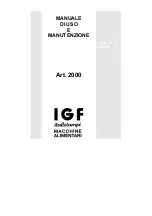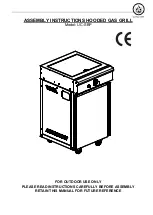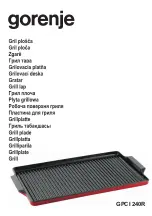
18
Changing from High to Low Temperature Setting
1. If the grill has been operating at a high temperature and is then set to a lower temperature,
the grill will take a long time to cool down as fire in the fire-pot will keep producing heat.
2. Open the lid to release heat until the displayed temperature drops close to the lower set
temperature, then shut the lid and continue cooking.
Wood Pellet Tips
1. The grill only uses as many pellets from the hopper as required to maintain the desired
temperature. It will not use all the pellets in the hopper each time it is used.
2. The grill uses pellets at a rate of 0.3 to 0.5kg per hour at low temperatures (<121ºC) and
up to 1.5kg per hour at high temperatures. Just pour in as many pellets as required for
the cook (plus a bit extra). Only fill the hopper if doing a very long cook.
3. Leaving pellets sitting for a long time (weeks) in the hopper can result in poor burning
results as the pellets can absorb moisture. Very moist pellets can even clog up the auger.
It is best to keep the pellets in an air-tight bag or container.
4. If not planning to use the grill for several weeks or longer, scoop out most of the pellets
with a plastic cup or bowl. Start the grill and run at a high temperature setting until the
remaining pellets in the hopper are used up. The grill will automatically turn OFF and
display LEr (low temp error) once the pellets run out, which is normal.
5. If the hopper is totally empty of wood pellets, follow the Initial Startup Instructions to
prime the the auger tube with fresh wood pellets. As soon as pellets drop into the fire-pot,
turn the controller dial to Shut Down then SMOKE to startup as normal.
High Temperature Searing
This Z Grills 7002B (V2, late 2021) features a vented
grease tray that allows for high temperature searing
on the left hand side of the grill.
A BBQ plate or skillet located above the vent holes can
reach temperatures of up to 300ºC, perfect for searing steaks.
Cast iron plates or skillets work best for searing as they have a large thermal mass (compared
to thin trays or racks), and so provide a more even and consistent temperature. They also
avoid grease dripping down onto the grease tray or through the holes into the grill area below,
making a mess that needs to be cleaned up.
This air vent design prevents direct flame contact, greatly reducing the chance of flare ups and
grease fires, while still providing high temperatures needed for effective searing.
Important tips:
•
Remove foil from the left hand side of the grease tray to uncover the vent holes. Keep the
holes covered during normal operation for even temperatures across the grilling area.
•
If using BBQ plates that fit front to back in the grill, the left grill rack can be removed.
Skillets or other trays can sit directly on the grill rack (trays must be rated for >320ºC).
•
For highest searing temperatures, set the grill to the highest temperature setting and
wait until the grill temperature stabilises before placing on food.
•
Cast iron plates and skillets take a long time to heat up, so put them into the grill as early
as possible, not just before placing on food.
•
The grill will loose heat rapidly with the lid open, so if you need to flip food, do it fast and
close the lid.
•
Never pour cold liquid onto a hot cast iron plate as it can crack due to rapid cooling.







































